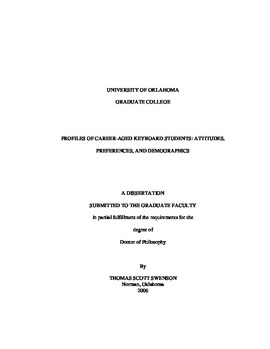| dc.contributor.advisor | Magrath, Jane, | en_US |
| dc.contributor.advisor | Barry, Nancy H., | en_US |
| dc.contributor.author | Swenson, Thomas Scott. | en_US |
| dc.date.accessioned | 2013-08-16T12:20:07Z | |
| dc.date.available | 2013-08-16T12:20:07Z | |
| dc.date.issued | 2006 | en_US |
| dc.identifier.uri | https://hdl.handle.net/11244/1029 | |
| dc.description.abstract | This study sought to determine profiles for career-aged adult keyboard students (30-55 years) based on motivation. Perspectives concerning student attitudes and opinions regarding teacher qualities and traits, preferred keyboard activities, and demographic variables were correlated to the initial typal profiles. | en_US |
| dc.description.abstract | The first phase of research involved requesting information on why adult students chose to enroll in keyboard lessons at that point in their lives. Sixty-two participants from 12 member community music schools of the National Guild of Community Music Schools of the Arts (NGCMSA) took part in this phase of the study. The 266 responses to the open ended question (concourse of statements) were analyzed. Eight hypothetical categories were determined and the statements were reduced to 64 (eight statements for each category). A distribution matrix with 64 boxes was created, ranging from "Least Agree" to "Most Agree." The second phase of the study recruited 20 participants from teachers of the North Carolina Music Teacher's Association to rank the statements according to their own motivations. The third phase, involving a revised questionnaire and Q-sort, was administered to 49 career-aged adult keyboard students of schools of the NGCSA. The Q-methodology analysis indicated at least three typal profiles. Discriminant casewise analysis indicated that 10 variables, taken together, could predict membership in each of the three profiles with 100% accuracy. | en_US |
| dc.description.abstract | Correlations between the Q-factors (motivational groupings) and the questionnaire contributed to the resultant three profiles. The Serious Amateur, the largest cohort, was motivated most by repertoire and skill acquisition. Other traits of this group included the enjoyment of public performance, the most prior keyboard training, minor interest in playing games during the lesson, a desire for more discussion in lessons, and enjoyment of duets and ensemble music with other students. The Late Bloomer participants generally shared a longtime desire to learn to play the piano. Additionally, this group had the least amount of prior keyboard training and little desire to make music with other students. The third profile, the Amicable Amateur, was motivated in the potential mental and physical benefits. This group desired a teacher who was friendly, flexible, and who demonstrated concepts. | en_US |
| dc.format.extent | xii, 180 leaves ; | en_US |
| dc.subject | Adult students. | en_US |
| dc.subject | Music as recreation. | en_US |
| dc.subject | Piano Instruction and study. | en_US |
| dc.subject | Education, Adult and Continuing. | en_US |
| dc.subject | Recreation. | en_US |
| dc.subject | Education, Music. | en_US |
| dc.subject | Music. | en_US |
| dc.title | Profiles of career-aged keyboard students: Attitudes, preferences, and demographics. | en_US |
| dc.type | Thesis | en_US |
| dc.thesis.degree | Ph.D. | en_US |
| dc.thesis.degreeDiscipline | School of Music | en_US |
| dc.note | Advisers: Nancy H. Barry; Jane Magrath. | en_US |
| dc.note | Source: Dissertation Abstracts International, Volume: 67-03, Section: A, page: 0777. | en_US |
| ou.identifier | (UMI)AAI3211367 | en_US |
| ou.group | Weitzenhoffer Family College of Fine Arts::School of Music | |
